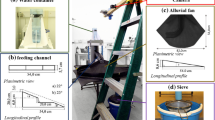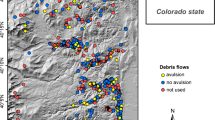Abstract
Alluvial fans are among the most privileged settlement areas in many mountain regions. These landforms are particularly dynamic being episodically affected by distributary processes generated by extreme flood events. Addressing risk assessment entails determining hazard exposure and unravelling how it might be related to process loading and to process dynamics once the flow becomes unconfined on the surface of alluvial fans. By following a ‘similarity of process concept’, rather than by attempting to scale a real-world prototype, we performed a set of 72 experimental runs on an alluvial fan model. Thereby, we considered two model layouts, one without a guiding channel and featuring a convex shape and the other one with a guiding channel, a bridge, and inclined but planar overland flow areas as to mirror an anthropic environment. Process magnitude and intensity parameters were systematically varied, and the associated biphasic distributary processes video recorded. For each experiment, the exposure was detected by mapping the exposed area in a GIS, thereby discerning between areas exposed to biphasic flows and the associated depositional phenomena or to the liquid flow phase only. Our results reveal that total event volume, sediment availability and stream power in the feeding channel, as well as depositional effects, avulsion, and channelization on the alluvial fan concur to determine the overall exposure. Stream process loading alone, even when rigorously defined in terms of its characterizing parameters, is not sufficient to exhaustively determine exposure. Hence, further developing reliable biphasic simulation models for hazard assessment on settled alluvial fans is pivotal.
Similar content being viewed by others
References
Anstey RL (1965) Physical characteristics of alluvial fans. Natick, MA: Army Natick Laboratory, Technical Report, ES-20.
Antronico L, Greco R, Robustelli G, et al. (2015) Short-term evolution of an active basin–fan system, Aspromonte, south Italy. Geomorphology 228: 536–551. https://doi.org/10.1016/j.geomorph.2014.10.013
Blair TC, McPherson JG (1994) Alluvial fans and their natural distinction from rivers based on morphology, hydraulic processes, sedimentary processes, and faces assemblages. Journal of Sedimentary Research 64: 451–490. https://doi.org/10.1306/D4267DDE-2B26-11D7-8648000102C1865D
Blair TC, McPherson JG (2009) Processes and forms of alluvial fans. Geomorphology of desert environments. Springer, Dordrecht: 413–467. https://doi.org/10.1007/978-1-4020-5719-9_14
Bryant M, Falk P, Paola C (1995) Experimental study of avulsion frequency and rate of deposition. Geology 23 (4): 365–368. https://doi.org/10.1130/0091-7613(1995)023<0365:ESOAFA>2.3.CO;2
Bull WB (1977) The alluvial-fan environment. Progress in Physical Geography 1 (2): 222–270. https://doi.org/10.1177/030913337700100202
Cenderelli DA, Wohl EE (2003) Flow hydraulics and geomorphic effects of glacial‐lake outburst floods in the Mount Everest region, Nepal. Earth Surface Processes and Landforms 28 (4): 385–407. https://doi.org/10.1002/esp.448
Clarke LE (2015) Experimental alluvial fans: Advances in understanding of fan dynamics and processes. Geomorphology 244: 135–145. https://doi.org/10.1016/j.geomorph.2015.04.013
Clarke L, Quine TA, Nicholas A (2010) An experimental investigation of autogenic behavior during alluvial fan evolution. Geomorphology 115 (3-4): 278–285. https://doi.org/10.1016/j.geomorph.2009.06.033
Clevis Q, de Boer P, Wachter M (2003) Numerical modelling of drainage basin evolution and three-dimensional alluvial fan stratigraphy. Sedimentary Geology 163 (1-2): 85–110. https://doi.org/10.1016/S0037-0738(03)00174-X
D’Agostino V, Cesca M, Marchi L (2009) Field and laboratory investigations of runout distances of debris flows in the Dolomites (Eastern Italian Alps). Geomorphology 115 (3-4): 294–304. https://doi.org/10.1016/j.geomorph.2009.06.032
Davies TRH, McSaveney MJ, Clarkson PJ (2003) Anthropic aggradation of the Waiho River, Westland, New Zealand: microscale modelling. Earth Surface Processes and Landforms 28: 209–218. https://doi.org/10.1002/esp.449
De Haas T, Densmore AL, Stoffel M, et al. (2018) Avulsions and the spatio-temporal evolution of debris-flow fans. Earth-Science Reviews 177: 53–75. https://doi.org/10.1016/j.earscirev.2017.11.007
Dean DJ, Schmidt JC (2013) The geomorphic effectiveness of a large flood on the Rio Grande in the Big Bend region: Insights on geomorphic controls and post-flood geomorphic response. Geomorphology 201: 183–198. https://doi.org/10.1016/j.geomorph.2013.06.020
Drew F (1873) Alluvial and lacustrine deposits and glacial records of the Upper-Indus Basin. Quarterly Journal of the Geological Society 29(1-2): 441–471. https://doi.org/10.1144/GSL.JGS.1873.029.01-02.39
Fuchs S (2009) Susceptibility versus resilience to mountain hazards in Austria-paradigms of vulnerability revisited. Natural Hazards and Earth System Sciences 9: 337–352. https://doi.org/10.5194/nhess-9-337-2009
Fuchs S, Keiler M, Zischg A (2015) A spatiotemporal multihazard exposure assessment based on property data. Natural Hazards and Earth System Sciences 15 (9): 2127–2142. https://doi.org/10.5194/nhess-15-2127-2015
Fuchs S, Karagiorgos K, Kitikidou K, et al. (2017a) Flood risk perception and adaptation capacity: a contribution to the socio-hydrology debate. Hydrology and Earth System Sciences 21 (6): 3183–3198. https://doi.org/10.5194/hess-21-3183-2017
Fuchs S, Röthlisberger V, Thaler T, et al. (2017b) Natural hazard management from a co-evolutionary perspective: exposure and policy response in the European Alps. Annals of the American Association of Geographers 107 (2): 382–392. https://doi.org/10.1080/24694452.2016.1235494
Gray AB, Pasternack GB, Watson EB (2018) Estuarine abandoned channel sedimentation rates record peak fluvial discharge magnitudes. Estuarine, Coastal and Shelf Science 203: 90–99. https://doi.org/10.1016/j.ecss.2018.02.007
Guerit L, Métivier F, Devauchelle O, et al. (2014) Laboratory alluvial fans in one dimension. Physical Review 90: 022203. DOI: 10.1103/PhysRevE.90.022203
Harvey AM (2012) The coupling status of alluvial fans and debris cones: a review and synthesis. Earth Surface Processes and Landforms 37 (1): 64–76. https://doi.org/10.1002/esp.2213
Hooke RL (1968) Model geology: prototype and laboratory streams: discussion. Geological Society of America Bulletin 79: 391–394. https://doi.org/10.1130/0016-7606(1968)79[391:MGPALS]2.0.CO;2
James LA, Hodgson ME, Ghoshal S, et al. (2012) Geomorphic change detection using historic maps and DEM differencing: The temporal dimension of geospatial analysis. Geomorphology 137 (1): 181–198. https://doi.org/10.1016/j.geomorph.2010.10.039
Kain CL, Rigby EH, Mazengarb C (2018) A combined morphometric, sedimentary, GIS and modelling analysis of flooding and debris flow hazard on a composite alluvial fan, Caveside, Tasmania. Sedimentary Geology 364: 286–301. https://doi.org/10.1016/j.sedgeo.2017.10.005
Magilligan FJ (1992) Thresholds and the spatial variability of flood power during extreme floods. Geomorphology 5:3-5: 373–390. https://doi.org/10.1016/0169-555X(92)90014-F
Mazzorana B, Fuchs S (2010) A conceptual planning tool for hazard and risk management. In: Chen SC (ed.), Internationales Symposion Interpraevent in the Pacific Rim, Klagenfurt: Internationale Forschungsgesellschaft Interpraevent: 828–837.
Mazzorana B, Nardini A, Comiti F, et al. (2017a) Toward participatory decision-making in river corridor management: two case studies from the European Alps. Journal of Environmental Planning and Management 61 (7): 1250–1270. https://doi.org/10.1080/09640568.2017.1339593
Mazzorana B, Iribarren P, Oyarzun C, et al. (2017b) Determining patterns of flood hazard exposure on an experimental alluvial fan. Proceedings XX Congreso Geológico Argentino, Tucumán (7th-11th august), Technical session 3: 24–28.
Mazzorana B, Ruiz-Villanueva V, Marchi L, et al. (2018) Assessing and mitigating large wood-related hazards in mountain streams: recent approaches. Journal of Flood Risk Management 11: 207–222. https://doi.org/10.1111/jfr3.12316
Muto T, Steel RJ, Swenson JB (2007). Autostratigraphy: a framework norm for genetic stratigraphy. Journal of Sedimentary Research 77: 2–12. https://doi.org/10.2110/jsr.2007.005
Paola C, Straub K, Mohrig D, et al. (2009) The “unreasonable effectiveness” of stratigraphic and geomorphic experiments. Earth-Science Reviews 97: 1–43. https://doi.org/10.1016/j.earscirev.2009.05.003
Papathoma-Köhle M, Gems B, Sturm M, et al. (2017) Matrices, curves and indicators: a review of approaches to assess physical vulnerability to debris flows. Earth-Science Reviews 171: 272–288. https://doi.org/10.1016/j.earscirev.2017.06.007
Pelletier JD, Mayer L, Pearthree PA, et al. (2005) An integrated approach to flood hazard assessment on alluvial fans using numerical modeling, field mapping, and remote sensing. Geological Society of America Bulletin 117(9-10): 1167–1180. https://doi.org/10.1130/B255440.1
Rainato R, Mao L, Picco L (2017) Near-bankfull floods in an Alpine stream: Effects on the sediment mobility and bedload magnitude. International Journal of Sediment Research 33 (1): 27–34. https://doi.org/10.1016/j.ijsrc.2017.03.006
Reitz MD, Jerolmack DJ (2012) Experimental alluvial fan evolution: Channel dynamics, slope controls, and shoreline growth. JGR Earth Surface 117: F02021. https://doi.org/10.1029/2011JF002261
Röthlisberger V, Zischg AP, Keiler M (2017) Identifying spatial clusters of flood exposure to support decision making in risk management. Science of the Total Environment 598: 593–603. https://doi.org/10.1016/j.scitotenv.2017.03.216
Salgueiro AR, Machado MJ, Barriendos M, et al. (2013) Flood magnitudes in the Tagus River (Iberian Peninsula) and its stochastic relationship with daily North Atlantic Oscillation since mid-19th Century. Journal of Hydrology 502: 191–201. https://doi.org/10.1016/j.jhydrol.2013.08.008
Sanchez-Nuñez JM, Macías JL, Saucedo R, et al. (2015) Geomorphology, internal structure and evolution of alluvial fans at Motozintla, Chiapas, Mexico. Geomorphology 230: 1–12. https://doi.org/10.1016/j.geomorph.2014.10.003
Santangelo N, Santo A, Di Crescenzo G, et al. (2011) Flood susceptibility assessment in a highly urbanized alluvial fan: the case study of Sala Consilina (southern Italy). Natural Hazards and Earth System Sciences 11: 2765–2780. https://doi.org/10.5194/nhess-11-2765-2011
Schumm SA, Mosley MP, Weaver WE (1987) Experimental Fluvial Geomorphology. Wiley Interscience, New York. p 413.
Sturm M, Gems B, Keller F, et al. (2018a) Experimental analyses of impact forces on buildings exposed to fluvial hazards. Journal of Hydrology 565: 1–13. https://doi.org/10.1016/j.jhydrol.2018.07.070
Sturm M, Gems B, Keller F, et al. (2018b) Understanding impact dynamics on buildings caused by fluviatile sediment transport. Geomorphology 321: 45–59. https://doi.org/10.1016/j.geomorph.2018.08.016
Van Dijk M, Kleinhans MG, Postma G, et al. (2012) Contrasting morphodynamics in alluvial fans and fan deltas: effect of the downstream boundary. Sedimentology 59 (7): 2125–2145. https://doi.org/10.1111/j.1365-3091.2012.01337.x
Westoby MJ, Brasington J, Glasser NF, et al. (2012) Structurefrom-Motion’photogrammetry: A low-cost, effective tool for geoscience applications. Geomorphology 179: 300–314. https://doi.org/10.1016/j.geomorph.2012.08.021
Acknowledgements
The authorship acknowledges the support of the following 2 research projects: Project FONDECYT nr. 1170657 titled “The flood memory of a river system: using both experimental and field-based approaches to unravel the role of unsteady flow and antecedent flows on sediment dynamics during floods” funded by CONICYT and led by Luca Mao; Project FONDECYT nr. 1170413 titled “Morphological impacts in rivers affected by volcanic eruptions. Chaiten and Calbuco: similar disturbance but different fluvial evolution? (PIROFLUV)” funded by CONICYT and led by Andrés Iroumé.
Author information
Authors and Affiliations
Corresponding author
Electronic supplementary material
Rights and permissions
About this article
Cite this article
Mazzorana, B., Ghiandoni, E. & Picco, L. How do stream processes affect hazard exposure on alluvial fans? Insights from an experimental study. J. Mt. Sci. 17, 753–772 (2020). https://doi.org/10.1007/s11629-019-5788-x
Received:
Revised:
Accepted:
Published:
Issue Date:
DOI: https://doi.org/10.1007/s11629-019-5788-x




